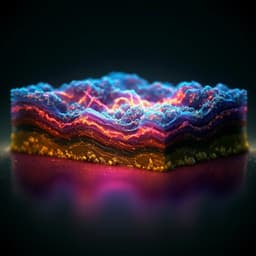
Physics
A quantum critical Bose gas of magnons in the quasi-two-dimensional antiferromagnet YbCl<sub>3</sub> under magnetic fields
Y. Matsumoto, S. Schnierer, et al.
Discover the fascinating phenomenon of quantum critical Bose–Einstein condensation in YbCl3, where researchers from Max Planck Institute for Solid State Research and University of Tokyo reveal how weak interlayer coupling can result in marginal BEC in quasi-2D systems. A groundbreaking study that pushes the boundaries of condensed matter physics!
~3 min • Beginner • English
Introduction
The study investigates whether a quasi-two-dimensional antiferromagnet can realize a Bose–Einstein condensate (BEC) in the 2D limit and exhibit quantum critical behavior accessible at moderate magnetic fields. While field-induced BEC of magnons is well established in 3D magnets, strict 2D systems cannot host BEC due to finite density of states at zero energy and Mermin–Wagner constraints. In layered magnets, however, an extremely weak interlayer coupling can marginally stabilize long-range order, allowing 2D physics to dominate. The honeycomb S = 1/2 Heisenberg antiferromagnet YbCl3 has a relatively low saturation field for in-plane magnetic fields, enabling detailed exploration of the field-driven quantum critical point (QCP). Mapping the spin system near saturation to an interacting dilute Bose gas, the authors aim to identify 2D-limit BEC critical exponents at the QCP, quantify the tiny interlayer coupling that stabilizes finite-temperature order below Hc, and determine the effective boson-boson interaction governing the 2D quantum critical Bose gas.
Literature Review
Previous work established field-induced magnon BEC in several 3D magnetic insulators such as TlCuCl3, BaCuSi2O6, and NiCl2·4SC(NH2)2, including detailed confirmation of 3D BEC critical exponents. Theoretical foundations include mapping of XY antiferromagnets near saturation to dilute Bose gases and the absence of true long-range order in strict 2D systems (Mermin–Wagner theorem), with BKT physics expected for 2D XY systems. In quasi-2D systems, small interlayer couplings can stabilize 3D long-range order with 2D signatures persisting at higher temperatures. YbCl3 was previously proposed as a Kitaev candidate, but inelastic neutron scattering has shown it to be an almost isotropic quasi-2D Heisenberg antiferromagnet with J ≈ 5 K and an extremely small interlayer coupling J⊥/J in the 10^-5–10^-3 range. Prior experiments reported a zero-field Néel transition near 0.6–0.65 K and field-induced transitions to a fully polarized state with Hc depending on field orientation. These works motivate an investigation of BEC quantum criticality in the 2D limit at experimentally accessible fields in YbCl3.
Methodology
Materials and crystal growth: Single-crystalline YbCl3 was synthesized via self-chemical-vapour transport from anhydrous YbCl3 (99.99%) in sealed quartz tubes. The source was heated to 900 °C then cooled to 750 °C at 1 °C/h with ~100 °C gradient. Crystals are thin plate-like, transparent, and of high quality, verified by negligible paramagnetic impurities in magnetization and boundary-limited thermal conductivity. Crystal orientations were checked by single-crystal X-ray diffraction. The in-plane a-axis (H || a) was used for all measurements.
Magnetization: M(T,H) was measured down to 50 mK using a homemade Faraday magnetometer in a 3He–4He dilution refrigerator. Multiple aligned crystals (~0.7 mg total) were measured, protected by Apiezon-N grease. Absolute calibration used field-dependent Faraday signals at 2 K cross-referenced to previous 1.8 K data, with calibration uncertainty ~1%. High-T consistency was confirmed by PPMS VSM measurements.
Specific heat: C(T,H) was measured by relaxation calorimetry on aligned crystals (~0.07 mg) with Apiezon-N grease. The total mass was determined by matching to polycrystalline C(T) at zero field below ~1 K where grease is negligible. The grease contribution (~15% at 2 K, ~T^2 dependence consistent with amorphous phonons) was subtracted from all datasets.
Thermal conductivity: κ(T,H) was measured by a steady-state method in a dilution refrigerator from 0.1–3 K on samples ~1 mm × 2 mm × 20 μm, sealed under argon before evacuation. Additional samples were measured in a 4He cryostat; results agreed in the overlapping 0.3–3 K range. κ(11.9 T) provided a phonon-only reference in the gapped fully polarized state for T < 2 K.
Analysis and modeling: The field-tuned transition near saturation is mapped to an interacting dilute Bose gas of magnons. The 2D honeycomb tight-binding model with nearest-neighbor hopping t = J/2 yields a constant 2D DOS at the band bottom D2D = sqrt(3)/(2J). Effective chemical potential μeff(T,H) = g μB (H − Hc) − 2 Ueff ⟨n⟩, with boson density ⟨n⟩ derived from magnetization ⟨n⟩ = 1 − M/Ms. At H = Hc, the number integral for a 2D Bose gas relates ⟨n⟩ and μeff and predicts linear-in-T behavior; deviations from the free-boson specific heat set Ueff. For H < Hc, a tiny interlayer coupling J⊥ rounds the 2D DOS near E = 0 into a 3D-like DOS ∝ sqrt(E) within an energy cutoff Ec ~ O(J⊥), enabling finite-T BEC. Tc(H) and ⟨n⟩ at Tc are modeled by combining the 2D DOS above Ec and the 3D contribution below, leading to ⟨n⟩c ≈ 2 D2D kB Tc (−ln(kB Tc/Ec) + 2). Above Hc, activation gaps Δ ≈ g μB (H − Hc) are extracted from thermally activated behavior of C and M near the fully polarized state. Thermal conductivity enhancements are interpreted via κmag = (1/2) Cmag ⟨v⟩ lmag with estimates of boson mass from the tight-binding band (t = J/2), thermal velocity ⟨v⟩, and lower bounds on mean free path lmag from Δκ/T at Hc.
Key Findings
- Field-driven quantum critical point: The saturation field for H || a is Hc = 5.93 ± 0.01 T, with saturation moment Ms = 1.72 μB/Yb. Above Hc the system is fully polarized with a gap that grows linearly with field, Δ ≈ g μB (H − Hc), where g ≈ 3.67.
- Exchange scales and dimensionality: In-plane nearest-neighbor exchange J = 5 K (0.42 meV). Interlayer coupling is extremely small, J⊥/J ≈ 2 × 10^-5 (order 10^-5–10^-3 from various estimates), corresponding to an energy scale Ec ≈ 0.2 mK (J⊥ ~ 0.1–10 mK), placing YbCl3 extremely close to the 2D limit.
- Zero-field order: C/T shows a broad 2D short-range order peak near ~1.2 K and a sharp Néel transition at Tc ≈ 0.65 K, consistent with previous reports; Tc initially rises with small H, then decreases to zero at Hc.
- 2D-limit BEC criticality at the QCP: At H = Hc, the system exhibits 2D BEC quantum critical exponents: C ∝ T (with C/T ≈ 0.99 J K^-2 Yb^-1 mol^-1 over T ≲ 1.2 K), and M(T) decreases linearly with T from Ms, implying ⟨n⟩ ∝ T. The phase boundary near Hc follows Tc ∝ (Hc − H) (2D expectation), contrasting with 3D expectation Tc ∝ (Hc − H)^2.
- Interacting 2D Bose gas: From ⟨n⟩(T) at Hc, the effective boson-boson interaction is Ueff ≈ 1.2 K ≈ 0.24 J, an order of magnitude smaller than in 3D BEC analogues. The measured C/T is reduced from the free 2D Bose-gas value (≈1.5 J K^-2 mol^-1 for J = 5 K) to ≈0.99 J K^-2 mol^-1 due to a T-linear negative shift of μeff, consistent with the interacting 2D gas model.
- Finite-T BEC below Hc due to J⊥: For H < Hc, anomalies in C(T) and M(T) mark a finite-T transition described quantitatively as BEC stabilized by the small interlayer coupling. Modeling with a DOS cutoff Ec ≈ 0.2 mK reproduces Tc(H) and ⟨n⟩ at Tc.
- 2D logarithmic renormalization: Ueff decreases only weakly with decreasing field (increasing ⟨n⟩), consistent with 2D logarithmic renormalization Ueff ≈ −U0 (1/ln ⟨n⟩ + 1/ln(J/J⊥)) with U0 ≈ 6 K and J⊥/J ≈ 2 × 10^-5. The finite Ueff at ⟨n⟩ → 0 is attributed to the 3D cutoff from J⊥.
- Thermal transport: A sharp, T-independent enhancement of thermal conductivity appears at Hc as a narrow vertical spike in Δκ/κ(11.9 T), with Δκ/T ≈ 0.13 W K^-2 m^-1 at 0.2 K. Analysis yields a large lower-bound mean free path lmag ≈ 0.3 μm for 2D bosons (⟨v⟩ ≈ 62 m s^-1), indicating highly mobile quantum critical bosons due to dilute density and reduced interactions near Hc.
Discussion
The results directly address whether a quasi-2D antiferromagnet can realize 2D-limit BEC quantum criticality at accessible fields. YbCl3 exhibits the hallmark 2D BEC critical exponents at Hc: C ∝ T and linear suppression of M(T) from Ms, and a linear Tc(H) near the QCP. The extremely small interlayer coupling J⊥ is sufficient to stabilize finite-T BEC for H < Hc, cutting off the 2D logarithmic divergence in the DOS and preventing a strict BKT transition. The extracted small Ueff and its weak density dependence match the expected 2D logarithmic renormalization of boson-boson interactions, cementing the 2D character of the quantum critical Bose gas. The singular, narrow enhancement of thermal conductivity centered at Hc, largely independent of T and not coincident with the C(H) peaks, points to a dramatic increase in mean free path rather than heat capacity, highlighting the high mobility of dilute 2D bosons with suppressed scattering near the QCP. Together, these observations establish YbCl3 as a clean platform to study interacting hard-core bosons in the 2D limit and the crossover from 2D quantum criticality to 3D ordered states induced by tiny interlayer coupling.
Conclusion
This work identifies and quantitatively characterizes a 2D-limit BEC quantum critical point in the honeycomb quasi-2D Heisenberg antiferromagnet YbCl3 at Hc = 5.93 T (H || a). At the QCP, thermodynamics follow 2D BEC critical exponents and are accurately captured by an interacting dilute 2D Bose gas model with a small effective interaction Ueff ≈ 0.24 J. For H < Hc, a minute interlayer coupling J⊥/J ≈ 2 × 10^-5 stabilizes finite-temperature BEC, with Tc(H) reproduced by including a 3D DOS cutoff Ec ≈ 0.2 mK. Thermal transport reveals a sharp, field-localized enhancement at Hc consistent with highly mobile 2D bosons with long mean free paths. These results establish YbCl3 as an ideal arena for exploring 2D interacting hard-core bosons, quantum criticality, and the interplay between 2D fluctuations and weak 3D coupling. Future studies could further probe the low-temperature regime below current limits to resolve 3D critical behavior, explore possible BKT-like signatures in the strict 2D limit, and tune interlayer coupling or disorder to test robustness of the 2D Bose gas phenomenology.
Limitations
- Temperature floor: Measurements down to 50–100 mK still exceed the extremely small interlayer energy scale (~0.1–10 mK), likely hiding parts of the 3D critical regime below accessible temperatures. The low-T limit of the specific-heat power below Tc could not be firmly established near Hc.
- Thermal transport analysis: Precise separation of phonon and magnetic contributions is challenging; κph is suppressed by magnon scattering, so Δκ/T gives a lower bound for κmag/T and lmag.
- Strict 2D limit: Since J⊥ is finite (though tiny), the study cannot directly observe a pure BKT transition; conclusions about proximity to BKT behavior are inferential.
- Modeling simplifications: The DOS crossover near E = 0 is approximated by a sharp cutoff Ec, and Ueff(⟨n⟩) is modeled phenomenologically with logarithmic renormalization and a 3D cutoff; microscopic details may introduce corrections.
Related Publications
Explore these studies to deepen your understanding of the subject.







